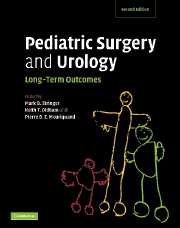Book contents
- Frontmatter
- Contents
- List of contributors
- Acknowledgments
- Preface
- Part I General issues
- Part II Head and neck
- Part III Thorax
- Part IV Abdomen
- Part V Urology
- Part VI Oncology
- 57 Late effects of the treatment of childhood cancer
- 58 Neuroblastoma
- 59 Wilms' tumor
- 60 Rhabdomyosarcoma
- 61 Liver tumors and resections
- 62 Extragonadal germ cell tumors
- 63 Hemangiomas and vascular malformations
- Part VII Transplantation
- Part VIII Trauma
- Part IX Miscellaneous
- Index
- Plate section
- References
63 - Hemangiomas and vascular malformations
from Part VI - Oncology
Published online by Cambridge University Press: 08 January 2010
- Frontmatter
- Contents
- List of contributors
- Acknowledgments
- Preface
- Part I General issues
- Part II Head and neck
- Part III Thorax
- Part IV Abdomen
- Part V Urology
- Part VI Oncology
- 57 Late effects of the treatment of childhood cancer
- 58 Neuroblastoma
- 59 Wilms' tumor
- 60 Rhabdomyosarcoma
- 61 Liver tumors and resections
- 62 Extragonadal germ cell tumors
- 63 Hemangiomas and vascular malformations
- Part VII Transplantation
- Part VIII Trauma
- Part IX Miscellaneous
- Index
- Plate section
- References
Summary
Introduction
Vascular anomalies consist of a diverse group of blood vessel disorders that typically present in childhood. Historically, the field is clouded by a confusing web of outdated and inappropriate terms that cross-medical disciplines and permeate the literature. For example, a venous malformation is often improperly referred to as a “cavernous hemangioma,” and “cystic hygroma” or “lymphangioma” is used to describe a lymphatic malformation. The suffix “oma”, when applied to malformations, incorrectly implies a disorder of endothelial proliferation and may overwhelm patients with fears of malignancy. Furthermore, clinicians might be tempted to “treat” these lesions with potent anti-angiogenic medications such as systemic steroids or interferon. Since these venous and lymphatic malformations are congenital, they will not respond to anti-angiogenic therapy. Patients are then placed at unnecessary risk of significant complications and side effects from these potent medications.
This confusion among patients and physicians led the International Society for the Study of Vascular Anomalies to adopt a general, biologic classification scheme (Table 63.1) for vascular anomalies based on physical findings, natural history, and cellular kinetics. In this system, vascular anomalies are described as either malformations or tumors. Vascular tumors exhibit abnormal endothelial cell proliferation while malformations are products of abnormal embryonic vessel development. This schema presents a useful framework for discussing the diagnosis and treatment of vascular anomalies. Although this standard system of nomenclature and classification exists, it is not consistently applied by physicians even in centers with an established vascular anomalies program.
- Type
- Chapter
- Information
- Pediatric Surgery and UrologyLong-Term Outcomes, pp. 826 - 842Publisher: Cambridge University PressPrint publication year: 2006

